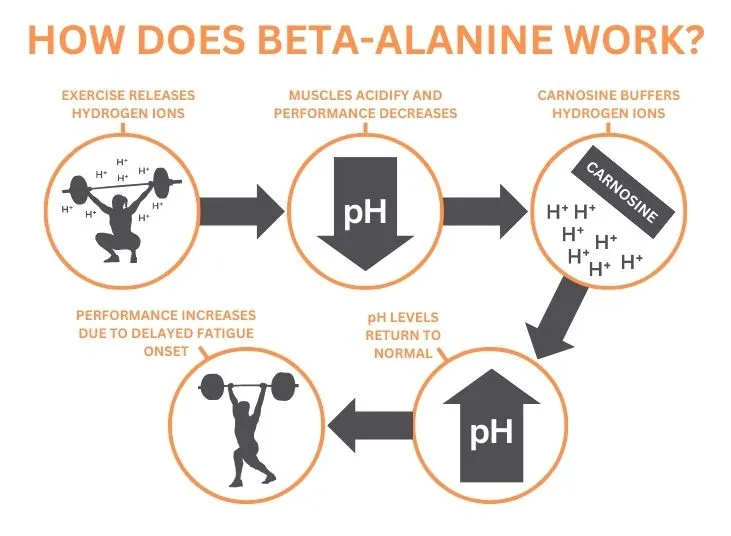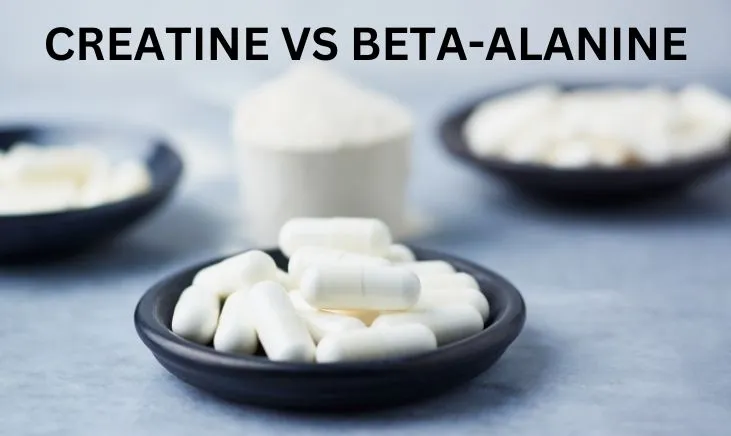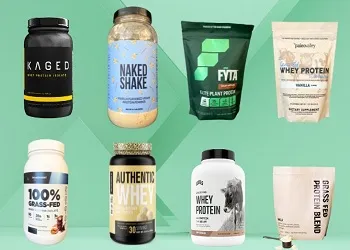Beta-alanine and creatine are arguably two of the most widely used fitness supplements. While both require a loading phase for optimal benefits, they don’t work on the same pathway. Beta-alanine is a beta amino acid that increases muscle carnosine levels, while creatine is an amino acid derivative that enhances ATP production. Stacking beta-alanine and creatine is the best option to enhance muscle growth, strength, body composition, and overall performance.
Quick Look
- Creatine is an amino acid derivative that increases phosphocreatine levels to enhance ATP production.
- Beta-alanine is a beta amino acid that boosts carnosine levels to buffer acid from muscles and prevent muscle fatigue.
- Beta-alanine and creatine both contribute to more significant muscle and strength gains, improve body composition, and support overall athletic performance.
- Stacking creatine and beta-alanine can maximize athletic performance benefits.
- A loading phase is required for both supplements—5 g/day of creatine combined with 4-6 g/day (divided into smaller doses throughout the day) of beta-alanine.
Table of Contents
What Is Creatine and What Does It Do?

Creatine is an amino acid derivative naturally synthesized in the liver and kidneys from three amino acids (arginine, glycine, and methionine) and primarily stored in muscle cells and other metabolically active tissues.
Its primary role is to serve as an energy substrate in the phosphocreatine (PCr) system, where it offers major advantages during high-intensity or power-based activities where energy demands increase significantly, such as heavy weightlifting, powerlifting, or sprints.
While the body naturally produces about 1-2 grams of creatine per day, supplementing with exogenous creatine is standard practice for many athletes and lifters due to its ability to increase skeletal muscle creatine concentrations and support lean muscle mass development and power.
Put simply, the high-energy phosphate bonds in phosphocreatine are broken to release energy to resynthesize ATP and supply fuel during high-intensity, explosive movements.
There are several types of creatine available in supplemental form—creatine monohydrate, creatine hydrochloride, creatine ethyl ester, creatine nitrate—but most research focuses on creatine monohydrate as the most effective and superior form.
How Creatine Works
The primary role of creatine is to supply energy to tissues with high energy demands, such as the brain and muscles. This happens through phosphocreatine’s high-energy phosphate bonds that are broken and can immediately replenish ATP stores during energy-demanding circumstances.
Note: Creatine phosphate (CP), or phosphocreatine (PCr), is the phosphorylated form of creatine that serves as a rapidly mobilized source of energy (ATP) via the breaking of phosphate bonds.
Here’s a simplified version of how creatine works to increase energy.
The body has an internal system that supplies energy during activity—it’s called the phosphagen system, which consists of two parts:
- ATP store
- Phosphocreatine (PC) or creatine phosphate store
The ATP store is small and can supply energy for roughly 1-2 seconds of maximal effort activity. Once ATP stores are drained, the body must rely on other sources of ATP to provide enough energy to meet the demands. Because muscles can’t obtain ATP from other tissues, they manufacture it with three components:
- ADP (adenosine diphosphate)
- Inorganic phosphate (Pi)
- Energy
ADP + Pi (plus energy) → ATP
One method of increasing ATP levels is to break down phosphocreatine. Breaking the high-energy phosphate bonds in PCr allows ATP to be resynthesized from ADP and Pi; PCr then degrades into creatine, a phosphate ion, and energy.
But while the ATP-PCr system can supply energy for about 5 to 8 seconds of maximal effort, it’s not enough to sustain intense activity for a long duration—that’s where creatine supplementation enters.
The theory behind taking exogenous creatine supplements is to increase intramuscular levels of creatine, subsequently increasing PCr concentrations for ATP production. The more energy you can produce, the harder you can work.
Key takeaway: Creatine and PCr are essential components of the ATP-PCr system that generate ATP via the breakdown of phosphocreatine stored in muscle cells. When the phosphate bond in PCr is broken, it releases energy to reconstitute ATP. The ATP-PCr system is the quickest source of ATP for active muscle tissue during high-energy-demand work.
Benefits of Creatine Supplements
- Increases muscle mass and strength
- Improves anaerobic powder
- Enhances cognitive function
- Accelerates muscle recovery
- Improves overall athletic performance
What Is Beta-Alanine and How Does It Work?

Beta-alanine is a non-proteinogenic and non-essential amino acid produced endogenously in the liver. But unlike most other amino acids, beta-alanine isn’t used to build proteins (hence, it’s non-proteinogenic). Instead, it’s bonded to a β-carbon instead of an α-carbon, meaning it serves a different function.
Instead of being used to build proteins, beta-alanine combines with another amino acid, L-histidine, to produce carnosine, a naturally occurring dipeptide stored within skeletal muscles that acts as an intramuscular proton buffer to maintain proper muscle pH.
Carnosine can also protect muscles against the harmful effects of free radicals produced during high-intensity or vigorous exercise. Because high levels of reactive oxygen species (ROS) generated during exercise can contribute to muscle fatigue and exercise-induced muscle damage, carnosine may protect muscles by scavenging free radicals to reduce levels of oxidative stress and prevent muscle damage.
But here’s the thing: Beta-alanine is the rate-limiting precursor to carnosine production, so if beta-alanine levels drop, your body can’t synthesize sufficient levels of carnosine to buffer muscles and prevent fatigue.
The solution: Supplement with beta-alanine. As with creatine supplementation, exogenous beta-alanine provides the substrate for carnosine production to improve exercise performance during high-intensity exercise and increase strength and power.
How Beta-Alanine Works
During high-intensity activity, anaerobic glycolysis serves as the primary energy pathway—glucose is broken down to produce ATP to power exercise. But glucose breakdown results in a buildup of lactate and hydrogen ions (H+) in the muscles, which increases muscle pH (hydrogen ions are acidic, and accumulation of them causes the muscles to become overly acidic). If a buffer isn’t present in the muscles to clear away excess hydrogen ions, muscles can reach their lowest pH, and hydrogen ions reach their maximum concentration within minutes.
Muscle acidity interferes with their ability to contract, leading to a loss of function and decrements in overall performance. But while increasing muscle acidity may not be the sole cause of fatigue during short-duration, high-intensity work, muscle acidosis interferes with other metabolic processes, inevitably leading to decreased force production.
In simple terms, here’s how carnosine works:
- Glucose is broken down during high-intensity exercise.
- Lactic acid is produced and converted into lactate, which increases hydrogen ion concentrations.
- Muscle acidity increases.
- Fatigue sets in.
- Carnosine buffers the acid to reduce muscle acidity and sustain muscle function.

The solution: Elevate muscle carnosine levels.
Carnosine acts as an intramuscular buffer to remove hydrogen ions from muscles and prevent fatigue. However, because carnosine synthesis depends on beta-alanine availability, supplementing with beta-alanine helps elevate carnosine levels in type I and type II muscle fibers and prevent the onset of muscular fatigue.
Many studies have shown that beta-alanine supplementation can increase carnosine levels by up to 58% in just four weeks and 80% in 10 weeks. Higher carnosine levels translate to delayed lactic acid build-up, helping you to train harder for longer.
Take a look at the chart below to see how different levels of beta-alanine supplementation can increase concentrations of muscle carnosine.

Figure adapted from Effects of β-alanine supplementation on exercise performance: a meta-analysis.
Benefits of Beta-Alanine
- Improves endurance during activity lasting over 60 seconds
- Delays fatigue/increases time to exhaustion (TTE)
- Increases strength
- Improves training volume
- Improves muscle endurance
- Optimizes recovery from high-intensity exercise
Beta-Alanine vs Creatine: What’s the Difference and Which Is Better?
Although creatine and beta-alanine both enhance athletic performance, muscle growth, and strength, there are a few fundamental differences between the two compounds.
Take a look at the chart below for a breakdown of creatine and beta-alanine.
| Creatine | Beta-Alanine | |
|---|---|---|
| Mechanism | Increases phosphocreatine levels to increase ATP production | Increases carnosine to inhibit lactic acid buildup |
| Goal | Increase energy production | Prevent muscle fatigue |
| Outcomes | Enhance energy to improve strength and power output | Increase time to exhaustion + improve training volume, strength, and performance |
| Type of compound | Amino acid derivative | Non-essential beta amino acid |
| Precursors | Arginine, methionine, and glycine | N/A |
| Synthesis location | Liver, kidneys, and pancreas | Liver |
So, when it comes to beta-alanine vs creatine, it’s not about which one is better—it’s about what your goals are. If you want to improve explosive power, creatine supplementation might be your best option. Conversely, if you want to improve training volume and prevent fatigue, beta-alanine might be more suitable.
The supplement you choose will be dictated by your training goals—and if you want to improve overall athletic performance, stacking them might be the best bet.
7 Benefits of Beta-Alanine and Creatine Stacking
Creatine and beta-alanine are backed by tremendous evidence and scientific research to support their ergogenic benefits, which is why they’re two of the most widely used fitness supplements.
But while both compounds offer unique results, stacking them has major benefits. Studies show that using beta-alanine and creatine supplementation together can lead to significant gains in strength, endurance, body composition, and performance compared to supplementing one or the other.
A study published in The International Journal Of Sports Nutrition And Exercise Metabolism looked at the effects of creatine and creatine plus beta-alanine on strength, power, body composition, and endocrine changes in collegiate football players over a 10-week resistance training program. Subjects were assessed on the following:
- Strength: Maximum bench press and squat
- Power: Wingate anaerobic power test, 20-jump test
- Body composition
- Blood samples: Total testosterone, cortisol, growth hormone, IGF-1, and sex hormone binding globulin (SHBG)

The group taking creatine and beta-alanine saw more remarkable changes in lean body mass and percent body fat compared to the creatine-only and placebo groups, while both the creatine and creatine + beta-alanine groups saw greater strength improvements than the placebo group. The creatine group saw higher resting testosterone levels, but no other endocrine changes were noted. Researchers concluded that combining beta-alanine and creatine supplementation offered the most effects on increasing lean tissue mass and improving body composition.
Together, beta-alanine and creatine have produced spectacular results for strength, endurance, and fatigue prevention.
Here’s a rundown of 7 benefits of stacking beta-alanine and creatine:
- Improve body composition
- Build muscle mass
- Increase aerobic endurance
- Prevent muscle fatigue
- Increase time to exhaustion
- Boost mental clarity and focus
- Accelerate recovery
How to Stack Beta-Alanine and Creatine
Stacking creatine and beta-alanine is a simple way to reap the most rewards from your training. While each supplement on its own can produce great results, successive intake can improve training adaptation further.
Some gym junkies believe that cycling on and off supplements can fast-track the process and prevent plateaus, but one of the most important things to consider with supplements is consistency. Some supplements produce the best results with cycling, but cycling with creatine and beta-alanine will likely compromise your results in the long run.
That said, base your supplement protocol on your fitness goals.
The supplementation strategy for beta-alanine is essential to maximize benefits. Like creatine, beta-alanine requires a chronic loading dose of 4 to 6 grams daily divided into doses of 2 grams or less for a minimum of two weeks (results in a 20-30% increase in muscle carnosine concentrations), with the most benefits seen after 4 weeks (40-60% increase). A larger dose of 6 grams divided into 4 equal doses of 1.5 grams would be optimal to maximize carnosine levels.

Note: Be sure to divide larger doses of beta-alanine. A single large bolus of beta-alanine can cause paraesthesia (i.e., tingling) and isn’t effective for performance outcomes, likely due to paraesthesia, rapid changes in pH, higher excretion rates, and lack of efficacy in loading the muscle contents. Taking beta-alanine alongside a meal during the loading phase also effectively increases muscle carnosine levels.
The lowdown: Aim for 5 grams of creatine and 3-4 grams of beta-alanine (divided) daily.
Frequently Asked Questions
Can you take beta-alanine with creatine?
Beta-alanine and creatine can be taken together or separately, although research shows the most benefits when stacked together. Since both supplements target different pathways, they can safely be consumed together to optimize muscle growth, strength, and overall athletic performance.
Does creatine make you itch?
Creatine doesn’t typically cause itching, but it can be a symptom of an allergic reaction. If you notice symptoms including rash, itching/swelling, severe dizziness, or trouble breathing, seek medical help immediately. However, do note that the most common side effect of beta-alanine supplementation is paraesthesia (tingling of the skin) and sometimes itching. It’s common when taken in single doses of 800 mg or more in a non-sustained release form.
Is beta-alanine more effective than creatine?
For sports that involve muscular endurance, beta-alanine might be the better option thanks to its ability to buffer muscle acidity and extend time to exhaustion. Conversely, if you want to improve strength and explosive power for sports like weightlifting or sprinting, creatine may provide the most benefits.
Does beta-alanine increase muscle growth?
Beta-alanine doesn’t directly increase muscle growth. However, due to its role in buffering lactic acid from muscles via augmenting carnosine concentrations, it has been shown to improve exercise performance and delay fatigue, which may support higher training volumes.














